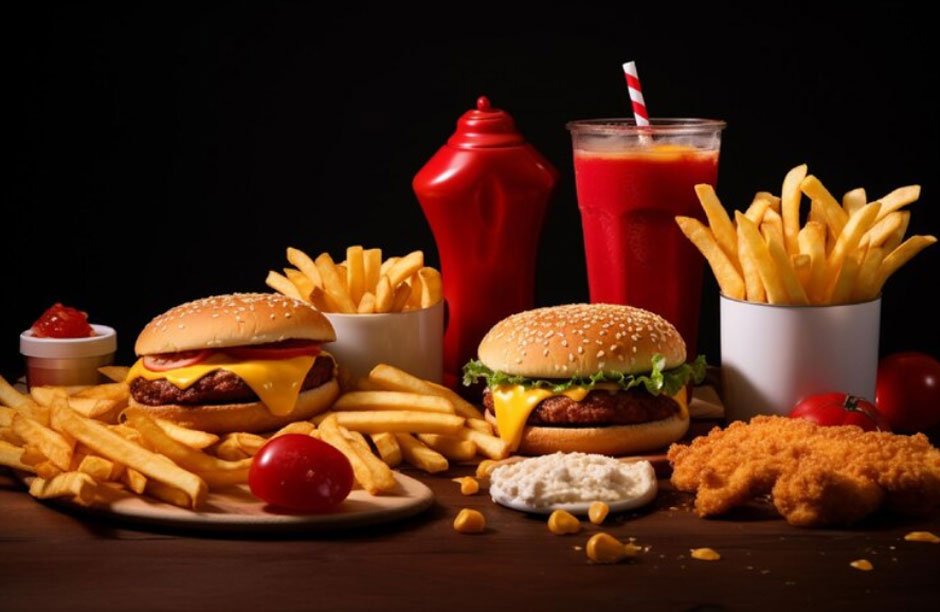Fast food has become a major part of modern life, providing people with quick, convenient, and affordable meal options around the world. But how did fast food grow to dominate the way we eat, and what is its impact on society today? From the first fast-food restaurants to today’s innovative drive-thrus and delivery apps, the story of fast food is one of creativity, efficiency, and sometimes controversy. In this article, we’ll explore the origins of fast food, why it’s so popular, and what the future might hold for this global phenomenon.
The History of Fast Food: Where It All Began
The fast-food industry started in the early 20th century in the United States, where industrialization and urbanization were changing the way people lived. As cities grew and people’s lives became busier, the need for quick meals grew. In 1921, White Castle opened in Wichita, Kansas, as one of the first fast-food chains, offering affordable and quick hamburgers that could be made in minutes.
The idea of fast food truly exploded in the 1950s with the rise of iconic brands like McDonald’s, Burger King, and KFC. The introduction of the “Speedee Service System” by the McDonald brothers set new standards for efficiency in food preparation, making it possible to serve customers faster than ever. Ray Kroc, a businessman, saw the potential in the McDonald’s model and expanded the franchise, turning McDonald’s into a global powerhouse.
Today, fast food has spread to nearly every corner of the world, with restaurants offering not just burgers and fries but also pizzas, fried chicken, tacos, and many other items tailored to local tastes.
Why is Fast Food So Popular?
Fast food owes its popularity to several key factors that make it appealing to people of all ages, lifestyles, and backgrounds. Here are some of the main reasons why fast food is loved by so many:
Convenience and Speed
The primary appeal of fast food is how quickly it can be prepared and served. For busy people who don’t have time to cook, fast food offers an easy way to grab a meal on the go. Most fast-food chains have streamlined their kitchens to ensure that meals are ready in just minutes, and with the rise of drive-thrus and delivery apps, it’s easier than ever to get food quickly without leaving your car or home.
Affordability
Fast food is usually more affordable than eating at sit-down restaurants, making it a go-to option for people on a budget. This accessibility makes it a popular choice for students, families, and anyone who needs a quick, inexpensive meal. Many fast-food chains offer value meals and combo deals, which make it possible to get a filling meal at a low price.
Consistent Taste
Another reason people love fast food is its consistency. Whether you’re in New York, Tokyo, or Dubai, you can expect a Big Mac from McDonald’s or a Whopper from Burger King to taste the same. This reliability gives people a sense of comfort and familiarity, especially when traveling or visiting new places.
Variety and Customization
Today, fast-food menus offer a wide variety of options, from classic burgers and fries to healthier choices like salads and grilled items. Many fast-food chains now allow customers to customize their orders, adding or removing ingredients to suit their tastes. This level of variety and customization helps fast food appeal to a wider audience.
The Global Impact of Fast Food
While fast food started in the United States, its influence has spread worldwide, impacting cultures, eating habits, and even economies. Here’s a look at some of the ways fast food has shaped the world.
Changing Food Culture
Fast food has changed the way people think about and approach meals. In many cultures, food is traditionally prepared at home and enjoyed slowly with family and friends. However, fast food has popularized the idea of eating quickly, often on the go, and has influenced traditional eating habits in many countries. For example, fast food has introduced burgers, fries, and soda to places where these foods were not part of the local cuisine.
Economic Influence
The fast-food industry is a significant part of the global economy, employing millions of people worldwide. Many young people get their first jobs working at fast-food restaurants, which can provide valuable work experience and skills. Fast-food chains also contribute to the economy through franchise systems, enabling local entrepreneurs to open their own restaurants under a global brand.
Health Concerns
Despite its popularity, fast food has faced criticism for its health impacts. Many fast-food items are high in calories, fats, sugars, and sodium, which can lead to health issues like obesity, diabetes, and heart disease if consumed frequently. Fast food’s accessibility and low cost can make it an easy choice for many, but nutrition experts warn about the health risks of eating it too often. In response to these concerns, some fast-food chains have added healthier options to their menus, like salads, grilled items, and low-calorie beverages.
The Future of Fast Food: What’s Next?
The fast-food industry is always evolving to meet changing tastes and needs. Here are some trends that could shape the future of fast food.
Healthier Menu Options
With growing awareness about health and nutrition, many fast-food restaurants are adding healthier options to their menus. This includes plant-based burgers, whole-grain buns, and items with reduced sugar and salt. Chains like Subway, Chipotle, and Panera Bread have built their brand around fresh, healthier choices, and traditional fast-food chains are following suit by offering more nutritious options.
Eco-Friendly Practices
Environmental sustainability is becoming a big focus in the fast-food industry. Many companies are working to reduce their carbon footprint by using eco-friendly packaging, reducing waste, and sourcing ingredients locally. For instance, McDonald’s has pledged to switch to fully recyclable packaging in the coming years, and Burger King is testing plant-based alternatives to its beef patties.
Technology and Automation
Technology is playing an increasingly important role in fast food. Many restaurants are introducing self-service kiosks, mobile ordering apps, and even robots for food preparation to streamline the ordering process. This technology not only speeds up service but also improves accuracy in orders. Additionally, with the rise of delivery apps like Uber Eats and DoorDash, customers can enjoy fast food with celebrating chilaquiles.
Global Fusion Foods
As fast food continues to spread worldwide, many chains are creating menu items inspired by local cuisines. For example, you might find teriyaki burgers in Japan, paneer pizza in India, or spicy chicken sandwiches in Mexico. This fusion of fast food with local flavors allows global chains to appeal to local tastes and celebrate the diversity of food culture.
FAQs About Fast Food
Curious about fast food? Here are some frequently asked questions:
What is considered fast food?
Fast food refers to food that is prepared and served quickly, usually at chain restaurants with standardized menus. Common fast-food items include burgers, fries, pizza, and fried chicken.
Why is fast food popular?
Fast food is popular because it’s convenient, affordable, and tasty. It allows people to get a quick meal without spending much time or money.
Is fast food unhealthy?
Many fast-food items are high in calories, fats, sugars, and sodium, which can lead to health issues if eaten too often. However, many chains now offer healthier options like salads and grilled items.
What are some healthier fast-food choices?
Healthier fast-food options include salads, grilled chicken sandwiches, and items with reduced portions of sauces and cheese. Some chains also offer plant-based options.
How has fast food changed over time?
Fast food has evolved to include more diverse menu options, healthier choices, and eco-friendly practices. Technology like self-service kiosks and mobile ordering has also changed how fast food is ordered and delivered.
Will fast food keep growing?
Yes, fast food is expected to keep growing, especially as new technology and healthier options appeal to a wider audience.
Conclusion
Fast food has transformed the way people eat, offering quick, affordable, and tasty meals for people worldwide. While it has faced criticism for health impacts, the industry continues to evolve by adding healthier options, embracing sustainability, and adapting to technology. Whether you’re a fan of classic burgers and fries or prefer healthier fast-food options, there’s no denying that fast food plays a big role in modern life, shaping our eating habits and food culture around the globe.









